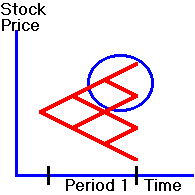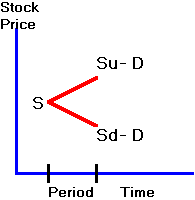![]() 3.5
Dividends and American Options
3.5
Dividends and American Options
You
have seen that for an American put option defined on a zero-dividend-paying
stock, the right to early exercise has value, while this is not the
case for an equivalent American call option.
Now we take a look at what happens to the call when the stock pays dividends.
To
see that this affects the exercise decision, think of the extreme case where the
underlying asset pays out one final liquidating dividend before the option
expires. Clearly, in this case if
you have an American call, you would want to exercise early! Thus there can be value to early exercise if the stock pays
dividends. Of course, if you had a
put, you would not exercise. This
already tells you the effect of dividends: they make early exercise of calls
more likely and early exercise of puts less likely.
To
take a closer look at the exercise value, suppose a dividend will be paid in the
period before the call expires. In
Figure 3.5 consider the circled portion of the tree and suppose that a dividend
is paid in this period before the call expires.
Figure 3.5
Tree Location Covering the
Dividend Payment Period

We
will do a one-period analysis from this node. Let the stock price at this node
be S, and suppose the stock will pay D per share in the next period, when the
call expires. This means that the
price of the stock can be represented as in Figure 3.6.
Figure 3.6
One-Period Model with Dividends

(Note
that the stock price in the last period must fall by exactly the amount of the
dividend; if it falls by more or by less, then there is an arbitrage
opportunity.)
If
we use risk-neutral valuation, we get
![]()
Now,
substitute the values of the call at expiration to get:
![]()
If
you exercise the call, you receive S - X.
Therefore, if D is large enough relative to Su
- X, it will pay you to exercise early.
For example, this is true if Su - D
- X = 0 and S - X > 0.
You
can repeat this analysis for a put option, where you should find that dividends
make early exercise less likely.
You
can make these valuation principles more concrete by working through some
applications. In topic 3.6,
Two-Period European versus American
Option Example, the two-period analysis is applied to regular European and
American options. In topic 3.7, Two-Period
Asian Option Example, we value an "Asian" option.
(C) Copyright 1999, OS
Financial Trading System